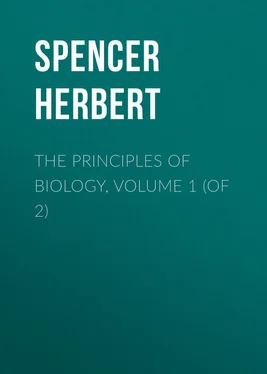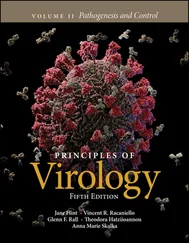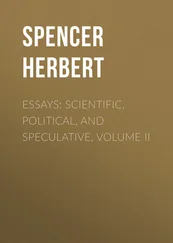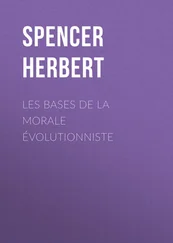Herbert Spencer - The Principles of Biology, Volume 1 (of 2)
Здесь есть возможность читать онлайн «Herbert Spencer - The Principles of Biology, Volume 1 (of 2)» — ознакомительный отрывок электронной книги совершенно бесплатно, а после прочтения отрывка купить полную версию. В некоторых случаях можно слушать аудио, скачать через торрент в формате fb2 и присутствует краткое содержание. Жанр: Философия, foreign_antique, foreign_prose, на английском языке. Описание произведения, (предисловие) а так же отзывы посетителей доступны на портале библиотеки ЛибКат.
- Название:The Principles of Biology, Volume 1 (of 2)
- Автор:
- Жанр:
- Год:неизвестен
- ISBN:нет данных
- Рейтинг книги:3 / 5. Голосов: 1
-
Избранное:Добавить в избранное
- Отзывы:
-
Ваша оценка:
- 60
- 1
- 2
- 3
- 4
- 5
The Principles of Biology, Volume 1 (of 2): краткое содержание, описание и аннотация
Предлагаем к чтению аннотацию, описание, краткое содержание или предисловие (зависит от того, что написал сам автор книги «The Principles of Biology, Volume 1 (of 2)»). Если вы не нашли необходимую информацию о книге — напишите в комментариях, мы постараемся отыскать её.
The Principles of Biology, Volume 1 (of 2) — читать онлайн ознакомительный отрывок
Ниже представлен текст книги, разбитый по страницам. Система сохранения места последней прочитанной страницы, позволяет с удобством читать онлайн бесплатно книгу «The Principles of Biology, Volume 1 (of 2)», без необходимости каждый раз заново искать на чём Вы остановились. Поставьте закладку, и сможете в любой момент перейти на страницу, на которой закончили чтение.
Интервал:
Закладка:
Here, however, as before, comparison of special truths, besides facilitating their interpretation, brings to light certain general truths. Contrasting functions bodily and mental as exhibited in various kinds of organisms, shows that there exists, more or less extensively, a community of processes and methods. Hence result two groups of propositions constituting General Physiology and General Psychology.
§ 40. In these divisions and subdivisions of the first two great departments of Biology, facts of Structure are considered separately from facts of Function, so far as separate treatment of them is possible. The third great department of Biology deals with them in their necessary connexions. It comprehends the determination of functions by structures, and the determination of structures by functions.
As displayed in individual organisms, the effects of structures on functions are to be studied, not only in the broad fact that the general kind of life an organism leads is necessitated by the main characters of its organization, but in the more special and less conspicuous fact, that between members of the same species, minor differences of structure lead to minor differences of power to perform certain actions, and of tendencies to perform such actions. Conversely, under the reactions of functions on structures in individual organisms, come the facts showing that functions, when fulfilled to their normal extents, maintain integrity of structure in their respective organs; and that within certain limits increases of functions are followed by such structural changes in their respective organs, as enable them to discharge better their extra functions.
Inquiry into the influence of structure on function as seen in successions of organisms, introduces us to such phenomena as Mr. Darwin's Origin of Species deals with. In this category come all proofs of the general truth, that when an individual is enabled by a certain structural peculiarity to perform better than others of its species some advantageous action; and when it bequeaths more or less of its structural peculiarity to descendants, among whom those which have it most markedly are best able to thrive and propagate; there arises a visibly modified type of structure, having a more or less distinct function. In the correlative class of facts (by some asserted and by others denied), which come under the category of reactions of function on structure as exhibited in successions of organisms, are to be placed all those modifications of structure which arise in races, when changes of conditions entail changes in the balance of their functions – when altered function externally necessitated, produces altered structure, and continues doing this through successive generations.
§ 41. The fourth great division of Biology, comprehending the phenomena of Genesis, may be conveniently separated into three subdivisions.
Under the first, comes a description of all the special modes whereby the multiplication of organisms is carried on; which modes range themselves under the two chief heads of sexual and asexual. An account of Sexual Multiplication includes the various processes by which germs and ova are fertilized, and by which, after fertilization, they are furnished with the materials, and maintained in the conditions, needful for their development. An account of Asexual Multiplication includes the various processes by which, from the same fertilized germ or ovum, there are produced many organisms partially or totally independent of one another.
The second of these subdivisions deals with the phenomena of Genesis in the abstract. It takes for its subject-matter such general questions as – What is the end subserved by the union of sperm-cell and germ-cell? Why cannot all multiplication be carried on after the asexual method? What are the laws of hereditary transmission? What are the causes of variation?
The third subdivision is devoted to still more abstract aspects of the subject. Recognizing the general facts of multiplication, without reference to their modes or immediate causes, it concerns itself simply with the different rates of multiplication in different kinds of organisms and different individuals of the same kind. Generalizing the numerous contrasts and variations of fertility, it seeks a rationale of them in their relations to other organic phenomena.
§ 42. Such appears to be the natural arrangement of divisions and subdivisions which Biology presents. It is, however, a classification of the parts of the science when fully developed; rather than a classification of them as they now stand. Some of the subdivisions above named have no recognized existence, and some of the others are in quite rudimentary states. It is impossible now to fill in, even in the roughest way, more than a part of the outlines here sketched.
Our course of inquiry being thus in great measure determined by the present state of knowledge, we are compelled to follow an order widely different from this ideal one. It will be necessary first to give an account of those empirical generalizations which naturalists and physiologists have established: appending to those which admit of it, such deductive interpretations as First Principles furnishes us with. Having done this, we shall be the better prepared for dealing with the leading truths of Biology in connexion with the doctrine of Evolution.
PART II.
THE INDUCTIONS OF BIOLOGY
CHAPTER I.
GROWTH
§ 43. Perhaps the widest and most familiar induction of Biology, is that organisms grow. While, however, this is a characteristic so uniformly and markedly displayed by plants and animals, as to be carelessly thought peculiar to them, it is really not so. Under appropriate conditions, increase of size takes place in inorganic aggregates, as well as in organic aggregates. Crystals grow; and often far more rapidly than living bodies. Where the requisite materials are supplied in the requisite forms, growth may be witnessed in non-crystalline masses: instance the fungous-like accumulation of carbon that takes place on the wick of an unsnuffed candle. On an immensely larger scale, we have growth in geologic formations: the slow accumulation of deposited sediment into a stratum, is not distinguishable from growth in its widest acceptation. And if we go back to the genesis of celestial bodies, assuming them to have arisen by Evolution, these, too, must have gradually passed into their concrete shapes through processes of growth. Growth is, indeed, as being an integration of matter, the primary trait of Evolution; and if Evolution of one kind or other is universal, growth is universal – universal, that is, in the sense that all aggregates display it in some way at some period.
The essential community of nature between organic growth and inorganic growth, is, however, most clearly seen on observing that they both result in the same way. The segregation of different kinds of detritus from each other, as well as from the water carrying them, and their aggregation into distinct strata, is but an instance of a universal tendency towards the union of like units and the parting of unlike units ( First Principles , § 163). The deposit of a crystal from a solution is a differentiation of the previously mixed molecules; and an integration of one class of molecules into a solid body, and the other class into a liquid solvent. Is not the growth of an organism an essentially similar process? Around a plant there exist certain elements like the elements which form its substance; and its increase of size is effected by continually integrating these surrounding like elements with itself. Nor does the animal fundamentally differ in this respect from the plant or the crystal. Its food is a portion of the environing matter that contains some compound atoms like some of the compound atoms constituting its tissues; and either through simple imbibition or through digestion, the animal eventually integrates with itself, units like those of which it is built up, and leaves behind the unlike units. To prevent misconception, it may be well to point out that growth, as here defined, must be distinguished from certain apparent and real augmentations of bulk which simulate it. Thus, the long, white potato-shoots thrown out in the dark, are produced at the expense of the substances which the tuber contains: they illustrate not the accumulation of organic matter, but simply its re-composition and re-arrangement. Certain animal-embryos, again, during their early stages, increase considerably in size without assimilating any solids from the environment; and they do this by absorbing the surrounding water. Even in the highest organisms, as in children, there appears sometimes to occur a rapid gain in dimensions which does not truly measure the added quantity of organic matter; but is in part due to changes analogous to those just named. Alterations of this kind must not be confounded with that growth, properly so called, of which we have here to treat.
Читать дальшеИнтервал:
Закладка:
Похожие книги на «The Principles of Biology, Volume 1 (of 2)»
Представляем Вашему вниманию похожие книги на «The Principles of Biology, Volume 1 (of 2)» списком для выбора. Мы отобрали схожую по названию и смыслу литературу в надежде предоставить читателям больше вариантов отыскать новые, интересные, ещё непрочитанные произведения.
Обсуждение, отзывы о книге «The Principles of Biology, Volume 1 (of 2)» и просто собственные мнения читателей. Оставьте ваши комментарии, напишите, что Вы думаете о произведении, его смысле или главных героях. Укажите что конкретно понравилось, а что нет, и почему Вы так считаете.












